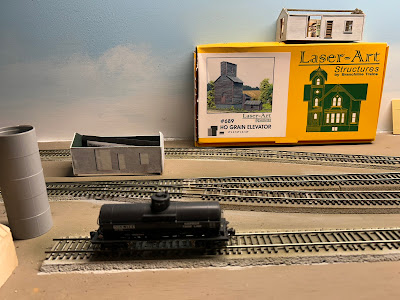After Dick Bradley commented last month, I went down the rabbit hole of learning about steam generators and clues to tell if a locomotive is appropriate for passenger service. The F7 that I have been using has no visible signs of having a steam generator, and F7 A units rarely had them. In GN passenger service A units were seldom used without being paired with a B unit, where the steam generator would be located. On the other hand, my GP7, seen above, does appear to have a steam generator in its short hood. The clues are the air intake dome and exhaust vent located among the short hood details. Looking at the prototype references mentioned in an earlier post and rooftop detail descriptions in this thread, my GP7 is much more applicable for use in passenger service than the F7 that I have been using. Since my last post, I have not made much progress on the combine, but I have gathered the parts I plan to use. Today I weighed the parts, the weights that came with the kit, the metal replacement wheels and the battery for the marker lights. Unfortunately I will need to add some additional weights to bring it up to NMRA recommended weight. As I configure how to wire the power switch into the underbody of the car, I will also have to figure where to add weight. I am reasonably happy with the weathering of the trucks, so I may as well start working my way upwards from there with construction of the car seen in my last post.
Whether they end up as passenger or freight power, both the F7 and GP7 need to be "broken in," so I have been using them in my first trial ops sessions. I mentioned before that I have struggled figuring out what my initial operations approach might be with Nooksack and East Branch as essentially a one-town approach. I am trying to work out a sequence system following the Fun for One approach of Byron Henderson. The first few sequence steps are working well for me, but when I transition to classification or small yard work I hit what my friend Mike Hauk calls "infrastructure" issues. As seen in the photo, the switch list ends up on the railroad. I need some sort of surface for writing the switch list. I don't know yet wether clipboard, shelf, or roll out desk is the answer. The agent desk approach that I discussed here and here may well work as the 4th Subdivision grows, but for this first phase it just seems to add an extra layer. To make up the switch list, I propped the car cards up against the cars and filled out the switch list before gathering and removing them. Now that the switch list is complete, I am set up to do some classifying and return to the sequence. After I work out some kinks, I will post with more detail on the sequence system.
Delving into the Ferndale Memories website for prototype passenger service ideas, I also reevaluated the industries that I am planning for Nooksack. The cannery, the team track, and the fuel dealer will all stay, but I am seriously considering replacing the planned Slease Supply with an elevator and a small feed supply building that I had started for my Meadville layout. In the arial shot and some photos of Ferndale on that website, a grain elevator and feed supply are located on a spur much like the spur here at Nooksack. As I work my way from rolling stock back to structure building, I am thinking that the grain company may better capture the atmosphere or feel of 1950s in Whatcom County.




A switch on the bottom of a car requires lifting and then rerailing the car. Consider instead a reed switch inside the roof of the car and operated by a rare earth magnet. The article on vehicle lighting in this month's RMC has good suggestions for this. Dick Bradley
ReplyDelete